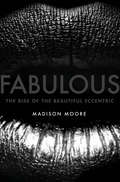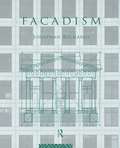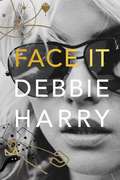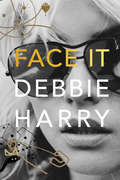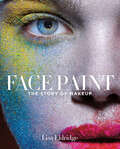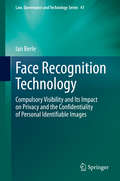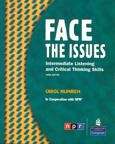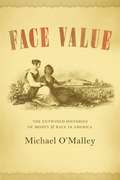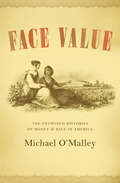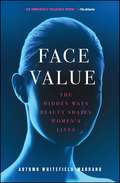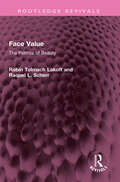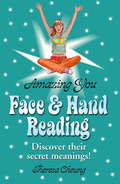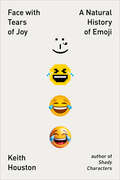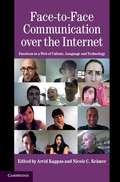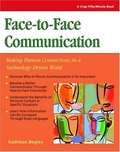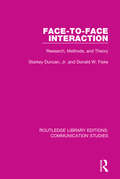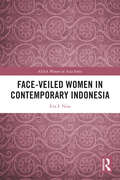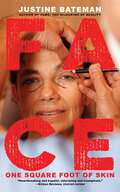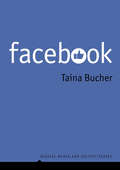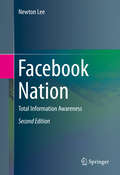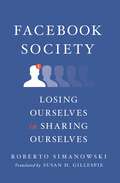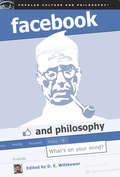- Table View
- List View
Fabulous: The Rise of the Beautiful Eccentric
by Madison MooreAn exploration of what it means to be fabulous—and why eccentric style, fashion, and creativity are more political than ever Prince once told us not to hate him ’cause he’s fabulous. But what does it mean to be fabulous? Is fabulous style only about labels, narcissism, and selfies—looking good and feeling gorgeous? Or can acts of fabulousness be political gestures, too? What are the risks of fabulousness? And in what ways is fabulous style a defiant response to the struggles of living while marginalized? madison moore answers these questions in a timely and fascinating book that explores how queer, brown, and other marginalized outsiders use ideas, style, and creativity in everyday life. Moving from catwalks and nightclubs to the street, moore dialogues with a range of fabulous and creative powerhouses, including DJ Vjuan Allure, voguing superstar Lasseindra Ninja, fashion designer Patricia Field, performance artist Alok Vaid†‘Menon, and a wide range of other aesthetic rebels from the worlds of art, fashion, and nightlife. In a riveting synthesis of autobiography, cultural analysis, and ethnography, moore positions fabulousness as a form of cultural criticism that allows those who perform it to thrive in a world where they are not supposed to exist.
Facadism
by Jonathan RichardsFacadism - the preservation of historic facades, the creation of facsimiles in front of new buildings and the decorative exercises of postmodernism - is accused of destroying architectural innovation, of divorcing the interior and exterior of buildings and of reducing townscapes to theatre sets. Its defenders describe facadism as the way urban tradition and progress walk hand in hand. Facadism presents a critical analysis of a concept central to the way in which the city is being remodelled. Assessing architectural and townscape philosophies and their aesthetics, the principles of urban conservation, the process of heritage planning and the market forces of urban development, the book builds a complete picture of the causes and effects of facadism in the Twentieth Century.
Face It
by Debbie HarryMusician, actor, activist, and the iconic face of New York City cool, Debbie Harry is the frontwoman of Blondie, a band that forged a new sound that brought together the worlds of rock, punk, disco, reggae and hip-hop to create some of the most beloved pop songs of all time. As a muse, she collaborated with some of the boldest artists of the past four decades. The scope of Debbie Harry's impact on our culture has been matched only by her reticence to reveal her rich inner life--until now. <p><p> In an arresting mix of visceral, soulful storytelling and stunning visuals, Face It upends the standard music memoir while delivering a truly prismatic portrait. With all the grit, grime, and glory recounted in intimate detail, Face It re-creates the downtown scene of 1970s New York City, where Blondie played alongside the Ramones, Television, Talking Heads, Iggy Pop and David Bowie. Aesthetically dazzling, and including never-before-seen photographs, bespoke illustrations and fan art installations, Face It brings Debbie Harry's world and artistic sensibilities to life. <p> Following her path from glorious commercial success to heroin addiction, the near-death of partner Chris Stein, a heart-wrenching bankruptcy, and Blondie's breakup as a band to her multifaceted acting career in more than thirty films, a stunning solo career and the triumphant return of her band, and her tireless advocacy for the environment and LGBTQ rights, Face It is a cinematic story of a woman who made her own path, and set the standard for a generation of artists who followed in her footsteps--a memoir as dynamic as its subject.
Face It: A Memoir
by Debbie HarryFilled with never-before-seen photos and art throughout, the much-anticipated autobiography from rock icon and lead singer of Blondie, Debbie HarryBRAVE, BEAUTIFUL AND BORN TO BE PUNKMusician, actor, activist, and the iconic face of New York City cool, Debbie Harry is the frontwoman of Blondie, a band that forged a new sound that brought together the worlds of rock, punk, disco, reggae and hip-hop to create some of the most beloved pop songs of all time. As a muse, she collaborated with some of the boldest artists of the past four decades. The scope of Debbie Harry’s impact on our culture has been matched only by her reticence to reveal her rich inner life—until now.In an arresting mix of visceral, soulful storytelling and stunning visuals, Face It upends the standard music memoir while delivering a truly prismatic portrait. With all the grit, grime, and glory recounted in intimate detail, Face It re-creates the downtown scene of 1970s New York City, where Blondie played alongside the Ramones, Television, Talking Heads, Iggy Pop and David Bowie. Aesthetically dazzling, and including never-before-seen photographs, bespoke illustrations and fan art installations, Face It brings Debbie Harry’s world and artistic sensibilities to life. Following her path from glorious commercial success to heroin addiction, the near-death of partner Chris Stein, a heart-wrenching bankruptcy, and Blondie’s breakup as a band to her multifaceted acting career in more than thirty films, a stunning solo career and the triumphant return of her band, and her tireless advocacy for the environment and LGBTQ rights, Face It is a cinematic story of a woman who made her own path, and set the standard for a generation of artists who followed in her footsteps—a memoir as dynamic as its subject.“I was saying things in songs that female singers didn’t really say back then. I wasn’t submissive or begging him to come back, I was kicking his ass, kicking him out, kicking my own ass too. My Blondie character was an inflatable doll but with a dark, provocative, aggressive side. I was playing it up yet I was very serious.”—From Face It
Face Off (Evelyn Talbot)
by Brenda NovakNew York Times bestseller Brenda Novak's third novel in the Evelyn Talbot series sees the return of psychiatrist Dr Evelyn Talbot in her purpose-built facility housing America's most terrifying psychopaths. This is SILENCE OF THE LAMBS meets Karen Rose...Over twenty years ago, Dr Evelyn Talbot was scarred for life when her teenage boyfriend Jasper Moore tortured her and left her for dead. And she fears one day he will return to finish what he started.Evelyn has tried to move forward and turned her trauma into her life's work. As a leading psychiatrist at Hanover House in remote Alaska, she is confronted with psychopaths and danger every day. She delves deep into their minds, despite the horrors that hide there, trying to figure out why they do what they do.When a woman goes missing from a nearby cabin, Evelyn immediately believes one of the Hanover House killers might be involved. But something about the case brings familiar and terrifying memories back to haunt her. She fears the truth may be closer, and darker, than she first imagined.
Face Paint: The Story of Makeup
by Lisa EldridgeThe “exquisite and richly illustrated” New York Times bestseller from the renowned makeup artist, “a retrospective written for all women, everywhere” (Vogue France).Makeup, as we know it, has only been commercially available in the last 100 years, but applying decoration to the face and body may be one of the oldest global social practices. In Face Paint, Lisa Eldridge reveals the entire history of the art form, from Egyptian and Classical times up through the Victorian age and golden era of Hollywood, and also surveys the cutting-edge makeup science of today and tomorrow. Face Paint explores the practical and idiosyncratic reasons behind makeup’s use, the actual materials employed over generations, and the glamorous icons that people emulate, it is also a social history of women and the ways in which we can understand their lives through the prism and impact of makeup.“Makeup artist and Lancome global creative director Lisa Eldridge drops serious knowledge in Face Paint, her book on the history of beautifying.” —Marie Claire“Clear your coffee table and turn off YouTube—Lisa Eldridge’s book is a must read.” —Teen Vogue “The book is not only rich with history but also with a series of paintings, sketches and photographs in an intense array of colors, selected by the make-up artist herself in the most aesthetically pleasing universal statement to women you’ll ever see.” —Vogue France“Face Paint delves into the history of makeup, with glossy pictures to match . . . the book’s cover is striking.” —New York Post
Face Recognition Technology: Compulsory Visibility and Its Impact on Privacy and the Confidentiality of Personal Identifiable Images (Law, Governance and Technology Series #41)
by Ian BerleThis book examines how face recognition technology is affecting privacy and confidentiality in an era of enhanced surveillance. Further, it offers a new approach to the complex issues of privacy and confidentiality, by drawing on Joseph K in Kafka’s disturbing novel The Trial, and on Isaiah Berlin’s notion of liberty and freedom. Taking into consideration rights and wrongs, protection from harm associated with compulsory visibility, and the need for effective data protection law, the author promotes ethical practices by reinterpreting privacy as a property right. To protect this right, the author advocates the licensing of personal identifiable images where appropriate.The book reviews American, UK and European case law concerning privacy and confidentiality, the effect each case has had on the developing jurisprudence, and the ethical issues involved. As such, it offers a valuable resource for students of ethico-legal fields, professionals specialising in image rights law, policy-makers, and liberty advocates and activists.
Face The Issues: Intermediate Listening And Critical Thinking Skills
by Carol Numrich National Public Radio (U.S.) StaffFace the Issues: Intermediate Listening and Critical Thinking Skills, Third Edition, by Carol Numrich, in cooperation with NPR®, helps intermediate students develop critical thinking skills as they gain insight into American attitudes and values. Each thought-provoking unit is based on an authentic radio broadcast from National Public Radio®. Students develop essential listening strategies such as predicting, looking at language, understanding main ideas and points of view, and focusing on details. Language and concepts are integrated through follow-up critical thinking activities including discussion, debate, values clarification, survey, role play, case study, inteview, and simulation.
Face Value: The Entwined Histories of Money and Race in America
by Michael O'MalleyFrom colonial history to the present, Americans have passionately, even violently, debated the nature and the character of money. They have painted it and sung songs about it, organized political parties around it, and imprinted it with the name of God--all the while wondering: is money a symbol of the value of human work and creativity, or a symbol of some natural, intrinsic value? In Face Value, Michael O'Malley provides a deep history and a penetrating analysis of American thinking about money and the ways that this ambivalence unexpectedly intertwines with race. Like race, money is bound up in questions of identity and worth, each a kind of shorthand for the different values of two similar things. O'Malley illuminates how these two socially constructed hierarchies are deeply rooted in American anxieties about authenticity and difference. In this compelling work of cultural history, O'Malley interprets a stunning array of historical sources to evaluate the comingling of ideas about monetary value and social distinctions. More than just a history, Face Value offers us a new way of thinking about the present culture of coded racism, gold fetishism, and economic uncertainty.
Face Value: The Entwined Histories of Money and Race in America
by Michael O'MalleyThe cultural historian and author of Keep Watching analyses American ideas about race, money, identity, and their surprising connections through history. From colonial history to the present, Americans have passionately, even violently, debated the nature and of money. Is it a symbol of the value of human work and creativity, or a symbol of some natural, intrinsic value? In Face Value, Michael O&’Malley provides a penetrating historical analysis of American thinking about money and the ways that this ambivalence intertwines with race. Like race, money is bound up in questions of identity and worth, each a kind of shorthand for the different values of two similar things. O&’Malley illuminates how these two socially constructed hierarchies are deeply rooted in American anxieties about authenticity and difference. In this compelling work of cultural history, O&’Malley interprets a wide array of historical sources to evaluate competing ideas about monetary value and social distinctions. More than just a history, Face Value offers a new way of thinking about the present culture of coded racism, gold fetishism, and economic uncertainty. &“This is a &‘big idea&’ book that no one but Michael O&’Malley could even have thought of—much less pulled off with such nuance and clarity.&”—Scott A. Sandage, author of Born Losers
Face Value: The Hidden Ways Beauty Shapes Women's Lives
by Autumn Whitefield-MadranoA thought-provoking examination of how we think and talk about beauty today--and the unexpected and often positive ways that beauty shapes our lives.For decades, we've discussed our insecurities in the face of idealized, retouched, impossibly perfect images. We've worried primping and preening are a distraction and a trap. But have we focused too much on beauty's negative influence? In Face Value, journalist Autumn Whitefield-Madrano thoughtfully examines the relationship between appearance and science, social media, sex, friendship, language, and advertising to show how beauty actually affects us day to day. Through meticulous research and interviews with dozens of women across all walks of life, she reveals surprising findings, like that wearing makeup can actually relax you, that you can convince people you're better looking just by tweaking your personality, and the ways beauty can be a powerful tool of connection among women. Equal parts social commentary, cultural analysis, careful investigation, and powerful personal anecdotes, Face Value is provocative and empowering--and a great conversation starter for women everywhere.
Face Value: The Politics of Beauty (Routledge Revivals)
by Robin Lakoff Raquel ScherrFirst published in 1984, Face Value confronts the pervasive power of beauty through art and literature, as well as interviews with men and women with varying perspectives on the subject. The topics covered range widely: the history of beauty from the Greeks to the present; the pathology of beauty: how women have been willing to harm themselves, mentally and physically, to achieve ‘beauty’; the language we use to speak of beauty, and its implications; our attitudes towards beauty, as examined by psychologists; beauty and ethnic identity; men and beauty. The authors present in fact a redefinition of beauty, enabling both women and men to enjoy it in themselves and in others, while discarding the sex-role stereotypes that have governed the definition of beauty in the past. With a new preface that explores the gaps created by time in the book’s discourse, this book will be of interest to students of linguistics, gender studies, women’s studies, cultural studies, sociology and anthropology.
Face and Hand Reading (Amazing You #24)
by Theresa Cheung"I've always hated my nose. The way it looks, and the fact that it's so big. When I was little I'd do drawings of smiling faces with no noses. My parents and teachers would always remind me to draw the nose, but I never did. The way I see my nose has changed since I started face reading. If only I'd known sooner that having a long nose is pretty cool." - Sarah, 12You can learn the most amazing things by simply using your face and hands (and a little help from this book). You see faces everyday but do you really look at them? Face reading helps you to analyse every feature, line and shape and work out what they say about your personality, relationships and future destiny. Hand reading, or palmistry, is another brilliant way to find out all about you and your friends and family. By looking at your whole hand, fingers and thumbs, and lines on your palms you'll see just how useful and informative hand reading can be in your everyday life. Face and Hand Reading shows you how you can change your life by discovering just how incredible and unique you are. It is part of our stunning new Mind Body Spirit series for teenage girls - Amazing You.
Face to Face with Emotions in Health and Social Care
by Benjamin GrayThis book draws from the everyday experiences as well as the harsh realities confronting behavioral care providers on the frontline. The book recounts the stories and sometimes disturbing emotions of people whose lives have undergone sudden change or even drastic trauma; people whose feelings of comfort and safety have been shattered by exposure to illness, abuse, death and bereavement. The perspectives and experiences of nurses, social care staff, patients, children and families are at the core of understanding the importance, challenges and therapeutic vitality of emotions. The 55 individuals on the frontline who took part in the interviews on which this study is based discuss the emotions associated with care in mental health, pediatric oncology, AIDS/HIV, as well as child protection and abuse, racism, refugee exile, poverty, and social exclusion. Their bravery, openness, and ability to communicate and share their emotions make this book possible.
Face with Tears of Joy: A Natural History of Emoji
by Keith HoustonA vibrant exploration of the world’s newest language—where it came from, how it works, and where it’s going. We are surrounded by emoji. They appear in politics, movies, drug deals, our sex lives, and more. But emoji’s impact has never been explored in full. In this rollicking tech and pop culture history, Keith Houston follows emoji from its birth in 1990s Japan, traces its Western explosion in the 2000s, and considers emoji’s ever-expanding lexicon. Named for the world’s most popular pictogram, Face with Tears of Joy tells the whole story of emoji for the first time.
Face-to-Face Communication over the Internet
by Arvid Kappas Nicole C. KrämerSocial platforms such as MySpace, Facebook and Twitter have rekindled the initial excitement of cyberspace. Text-based, computer-mediated communication has been enriched with face-to-face communication such as Skype, as users move from desktops to laptops with integrated cameras and related hardware. Age, gender and culture barriers seem to have crumbled and disappeared as the user base widens dramatically. Other than simple statistics relating to e-mail usage, chatrooms and blog subscriptions, we know surprisingly little about the rapid changes taking place. This book assembles leading researchers on nonverbal communication, emotion, cognition and computer science to summarize what we know about the processes relevant to face-to-face communication as it pertains to telecommunication, including video-conferencing. The authors take stock of what has been learned regarding how people communicate, in person or over distance, and set the foundations for solid research helping to understand the issues, implications and possibilities that lie ahead.
Face-to-Face Communication: Making Human Connections in a Technology-Driven World
by Kathleen A. BegleyEven as technology has allowed us to connect with an ever-expanding global network through the click of a mouse, face-to-face communication is still as important as ever. Improving one's in-person communication may seem nonessential and downright quaint in this computerized age, yet many workplace situations, often those involving conflict, feelings, or other sensitive issues, still demand human contact. FACE-TO-FACE COMMUNICATION explores why personal contact remains the most powerful type of human interaction and what readers can do to improve their skills to become excellent communicators.
Face-to-Face Interaction: Research, Methods, and Theory (Routledge Library Editions: Communication Studies #3)
by Donald W. Fiske Starkey DuncanOriginally published in 1977. This book focuses on how to do research in the area of face-to-face interaction when studying human social conduct. It covers the methods of data collection and analysis and looks at the efficiency of these. It secondarily considers a model for conceptualising such interactions, drawing together several social science components, especially linguistics, based on the idea that there is an organisational structure at work just as with grammar for language. Overall the book proposes a general conceptual framework for guiding empirical investigation, with emphasis on simultaneous study of a number of acts viewed within each other’s contexts. This is an excellent resource for study on non-verbal communications, describing specific studies as well as offering the clear overview and model for research.
Face-veiled Women in Contemporary Indonesia (ASAA Women in Asia Series)
by Eva F. NisaFace veiling is relatively new in Indonesia. It is often stereotyped as a sign of extremism and the growing Arabisation of Indonesian Muslims. It is also perceived as a symbol that demonstrates a lack of female agency. However, increasing numbers of women are choosing to wear the cadar (the full face veil). This book provides an ethnographic study of these women: why they choose to wear the cadar, embody strict religious disciplinary practices and the consequences of that choice. The women in this book belong to two Islamic revivalist movements: various Salafi groups and the Tablīghī Jamāʿat. Indonesia has constantly witnessed transformations in the meanings and practices of Islam, and this book demonstrates that women are key actors in this process. Nisa demonstrates that contrary to stereotypes, the women in this study have an agency which is expressed through their chosen docility and obedience.
Face: One Square Foot Of Skin
by Justine BatemanWriter/director/producer Justine Bateman examines the aggressive ways that society reacts to the aging of women's faces. "Face . . . is filled with fictional vignettes that examine real-life societal attitudes and internal fears that have caused a negative perspective on women's faces as they age." —TODAY Show, a Best Book of 2021 "There is nothing wrong with your face. At least, that's what Justine Bateman wants you to realize. Her new book, Face: One Square Foot of Skin, is a collection of fictional short stories told from the perspectives of women of all ages and professions; with it, she aims to correct the popular idea that you need to stop what you're doing and start staving off any signs of aging in the face." —W "Combining the author's intensely personal stories with relevant examples from the culture at large, the book is heartbreaking and hopeful, infuriating and triumphant." —Kirkus Reviews, starred review Face is a book of fictional vignettes that examines the fear and vestigial evolutionary habits that have caused women and men to cultivate the imagined reality that older women's faces are unattractive, undesirable, and something to be "fixed." Based on "older face" experiences of the author, Justine Bateman, and those of dozens of women and men she interviewed, the book presents the reader with the many root causes for society's often negative attitudes toward women's older faces. In doing so, Bateman rejects those ingrained assumptions about the necessity of fixing older women's faces, suggesting that we move on from judging someone's worth based on the condition of her face. With impassioned prose and a laser-sharp eye, Bateman argues that a woman's confidence should grow as she ages, not be destroyed by society's misled attitude about that one square foot of skin.
Facebook (Digital Media and Society #104)
by Taina BucherFacebook has fundamentally changed how the world connects. No other company has played a greater role in the history of social networking online. Yet Facebook is no longer simply a social networking site or social media platform. Facebook is Facebook. Taina Bucher shows how Facebook has become an idea of its own: something that cannot be fully described using broader categories. Facebook has become so commonplace that most people have a conception of what it is, yet it increasingly defies categorization. If we want to understand Facebook's power in contemporary society and culture, Bucher argues, we need to start by challenging our widespread conception of what Facebook is. Tracing the development and evolution of Facebook as a social networking site, platform, infrastructure and advertising company, she invites readers to consider Facebook anew. Contrary to the belief that nobody uses Facebook anymore, Facebook has never been more powerful. This timely book is important reading for students and scholars of media and communication, as well as anyone seeking to understand the Facebook phenomenon.
Facebook Nation
by Newton LeePresident Barack Obama, in his 2011 State of the Union Address, called America "the nation of Edison and the Wright brothers" and "of Google and Facebook." U.S. Chief Information Officer, Steven VanRoekel, said that America has become a "Facebook nation" that demands increased transparency and interactivity from the federal government. Facebook as a nation in 2012 would be the third largest country in the world with over 900 million citizens, after China and India. This book portrays the social media ecosystem as a world of increasing Total Information Awareness, which is essentially a civilian version of the controversial Total Information Awareness program unveiled in 2002 by the Defense Advanced Research Projects Agency (DARPA) at the U.S. Department of Defense. Back in the 60's, DARPA initiated and funded the research and development of Advanced Research Projects Agency Network (ARPANET) that went online in 1969. The success of ARPANET gave rise to the global commercial Internet in the 90's and the new generation of Fortune 500 companies today including Amazon.com, Google, eBay, and Yahoo!. As if life comes full circle in the 21st century, private businesses and the ubiquity of social networks such as Facebook, Google+, Twitter, and YouTube are creating the technologies and infrastructures necessary for the DARPA-proposed Total Information Awareness program. WikiLeaks founder Julian Assange called Facebook "the most appalling spying machine that has ever been invented." Indeed, military and civilian technologies have interwoven into every fabric of our society, as Facebook co-founder and CEO Mark Zuckerberg said, "We exist at the intersection of technology and social issues." This book offers discourse and practical advice on the privacy issue in the age of big data, the rise of Facebook nation, and Total Information Awareness. Opening with President Ronald Reagan's 1984 National Security Decision Directive and ending with George Orwell's novel 1984, the author takes us on a roller-coaster ride through Facebook's botched IPO, Carrier IQ, Kony 2012, SOPA/PIPA blackout, cyber bullying, crime fighting, and a host of other timely issues facing our Facebook nation. Social media strategists, information architects, social scientists, policymakers, and academic scholars in the Program in Science, Technology, and Society (STS) will find this book a valuable asset.
Facebook Society: Losing Ourselves in Sharing Ourselves
by Roberto SimanowskiFacebook claims that it is building a “global community.” Whether this sounds utopian, dystopian, or simply self-promotional, there is no denying that social-media platforms have altered social interaction, political life, and outlooks on the world, even for people who do not regularly use them. In this book, Roberto Simanowski takes Facebook as a starting point to investigate our social-media society—and its insidious consequences for our concept of the self.Simanowski contends that while they are often denounced as outlets for narcissism and self-branding, social networks and the practices they cultivate in fact remake the self in their image. Sharing is the outsourcing of one’s experiences, encouraging unreflective self-narration rather than conscious self-determination. Instead of experiencing the present, we are stuck ceaselessly documenting and archiving it. We let our lives become episodic autobiographies whose real author is the algorithm lurking behind the interface. As we go about accumulating more material for the platform to arrange for us, our sense of self becomes diminished—and Facebook shapes a subject who no longer minds. Social-media companies’ relentless pursuit of personal data for advertising purposes presents users with increasingly targeted, customized information, attenuating cultural memory and fracturing collective identity. Presenting a creative, philosophically informed perspective that speaks candidly to a shared reality, Facebook Society asks us to come to terms with the networked world for our own sake and for all those with whom we share it.
Facebook and Philosophy
by D. E. WittkowerFacebook and Philosophy is an entertaining, multi-faceted exploration of what Facebook means for us and for our relationships. With discussions ranging from the nature of friendship and its relationship to "friending," to the (debatable) efficacy of "online activism," this book is the most extensive and systematic attempt to understand Facebook yet. And with plenty of new perspectives on Twitter and Web 2.0 along the way, this fun, thought-provoking book is a serious and significant contribution for anyone working with social media, whether in academia, journalism, public relations, activism, or business. Exploring far-reaching questions - Can our interactions on Facebook help us care about each other more? Does Facebook signal the death of privacy, or (perhaps worse yet) the death of our desire for privacy? - Facebook and Philosophy is vital reading for anyone involved in social networks today.
Facebook and the: How the Social Network Reshaped the Legal Framework (Law, Governance and Technology Series #48)
by Philippe JougleuxThe past two decades have seen a radical change in the online landscape with the emergence of GAFAM (Google, Amazon, Facebook, Apple and Microsoft). Facebook, specifically, has acquired a unique monopoly position among social media, and is part of the digital lives of billions of users. A mutual influence between Facebook and the legal framework has gradually emerged, as EU legislators and judges are on the one hand forced to accept the reality of new, widespread behaviors and practices and on the other have constructed a legal framework that imposes limits and rules on the use of the social network.This book offers a unique perspective on this relationship, exploring the various activities and services proposed by Facebook and discussing the attendant legal issues. Accordingly, questions concerning the GDPR, its principles, rights and obligations are in the center of the discussions. However, the book does not limit its scope to data protection: Facebook has also greatly contributed to a liberalization and democratization of speech. In accordance, the classic principles of media law must be revisited, adapted or suitably enforced on the platform. Intellectual property law governs what is owned and by whom, no matter whether raw data or informational goods are concerned. Frameworks on hate speech and fake news are the result of coregulation principles of governance, whereas defamation jurisprudence continues to evolve, considering the consequences of merely “liking” certain content. The economic model of advertising is also governed by strict rules. Above all, Facebook is currently caught in a dilemma of substantial interest for society as a whole: is it a neutral online intermediary, i.e., merely a passive player on the Internet, or is it transforming against its will into an editorial service? In conclusion, the book has a dual purpose. First, it proposes a global and practical approach to the EU legal framework on Facebook. Second, it explores the current limits and the ongoing transformation of EU Internet law as it steadily adapts to life in the new digital world.
